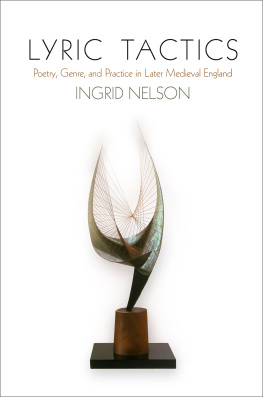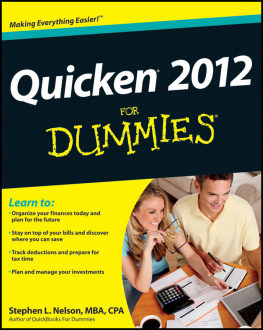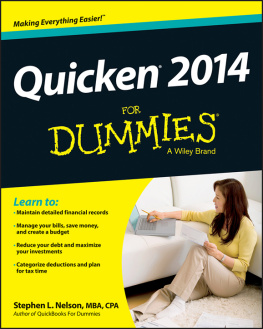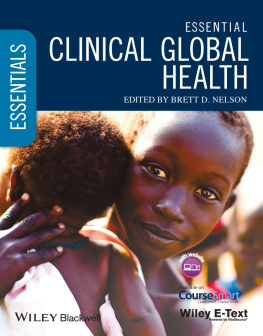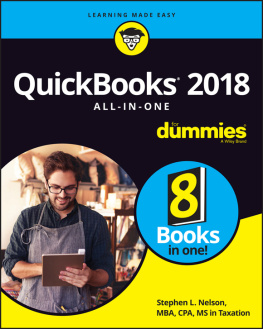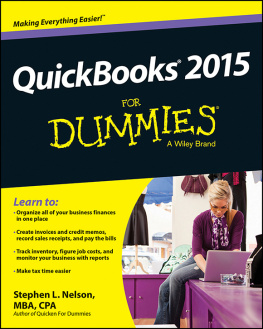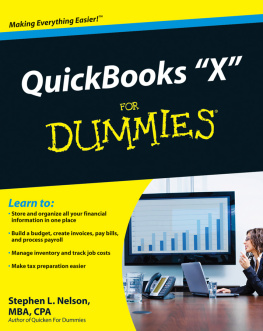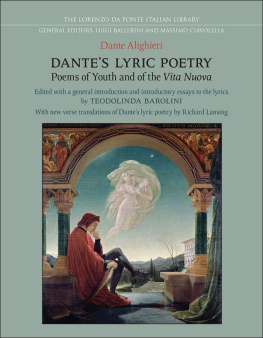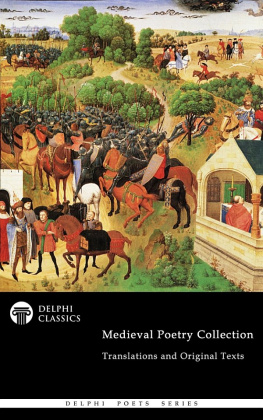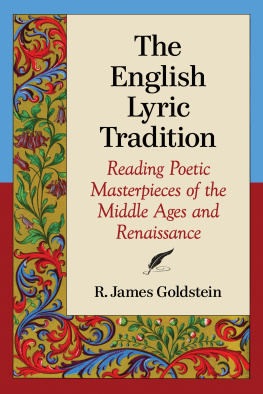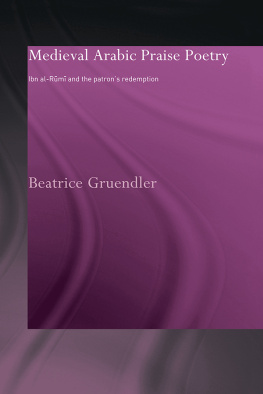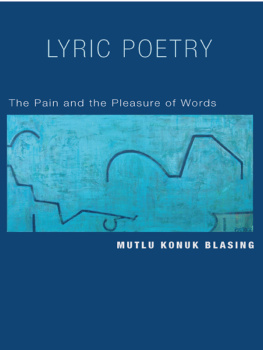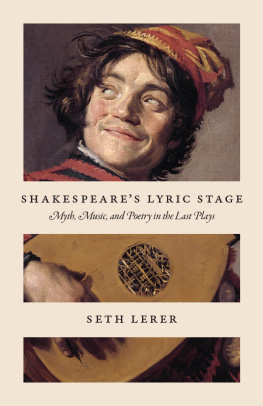Nelson - Lyric Tactics: poetry, genre, and practice in later medieval England
Here you can read online Nelson - Lyric Tactics: poetry, genre, and practice in later medieval England full text of the book (entire story) in english for free. Download pdf and epub, get meaning, cover and reviews about this ebook. City: Philadelphia, year: 2017;2017, publisher: University of Pennsylvania Press, genre: Religion. Description of the work, (preface) as well as reviews are available. Best literature library LitArk.com created for fans of good reading and offers a wide selection of genres:
Romance novel
Science fiction
Adventure
Detective
Science
History
Home and family
Prose
Art
Politics
Computer
Non-fiction
Religion
Business
Children
Humor
Choose a favorite category and find really read worthwhile books. Enjoy immersion in the world of imagination, feel the emotions of the characters or learn something new for yourself, make an fascinating discovery.
Lyric Tactics: poetry, genre, and practice in later medieval England: summary, description and annotation
We offer to read an annotation, description, summary or preface (depends on what the author of the book "Lyric Tactics: poetry, genre, and practice in later medieval England" wrote himself). If you haven't found the necessary information about the book — write in the comments, we will try to find it.
Nelson: author's other books
Who wrote Lyric Tactics: poetry, genre, and practice in later medieval England? Find out the surname, the name of the author of the book and a list of all author's works by series.
Lyric Tactics: poetry, genre, and practice in later medieval England — read online for free the complete book (whole text) full work
Below is the text of the book, divided by pages. System saving the place of the last page read, allows you to conveniently read the book "Lyric Tactics: poetry, genre, and practice in later medieval England" online for free, without having to search again every time where you left off. Put a bookmark, and you can go to the page where you finished reading at any time.
Font size:
Interval:
Bookmark:

Lyric Tactics
THE MIDDLE AGES SERIES
Ruth Mazo Karras, Series Editor
Edward Peters, Founding Editor
A complete list of books in the series is available from the publisher.
Lyric Tactics

Poetry, Genre, and Practice in Later Medieval England
Ingrid Nelson

UNIVERSITY OF PENNSYLVANIA PRESS
PHILADELPHIA
Copyright 2017 University of Pennsylvania Press
All rights reserved. Except for brief quotations used for purposes of review or scholarly citation, none of this book may be reproduced in any form by any means without written permission from the publisher.
Published by
University of Pennsylvania Press
Philadelphia, Pennsylvania 19104-4112
www.upenn.edu/pennpress
Printed in the United States of America on acid-free paper
1 3 5 7 9 10 8 6 4 2
A Cataloging-in-Publication record is available from the Library of Congress
ISBN 978-0-8122-4879-1
Lillian
In memoriam
CONTENTS

Introduction
The boat song of King Cnut survives in the twelfth-century monastic chronicle of Ely, making it the earliest post-Conquest evidence of an English lyric. The chronicle preserves the songs first quatrain, along with an account of its composition and performance:
When they were approaching the land, the king rose up in the middle of his men and directed the boatmen to make for the little port at full speed, and then ordered them to pull the boat forward more slowly as it came in. He raised his eyes towards the church which stood out at a distance, situated as it was at the top of a rocky eminence; he heard the sound of sweet music echoing on all sides, and, with ears alert, began to drink in the melody more fully the closer he approached. For he realized that it was the monks singing psalms in the monastery and chanting clearly the Divine Hours. He urged the others who were present in the boats to come round about him and sing, joining him in jubilation. Expressing with his own mouth his joyfulness of heart, he composed aloud a song in English the beginning of which runs as follows:
Merie sungen the munekes binnen Ely | monks |
Tha Cnut king rew ther-by | When; rowed |
Roweth, cnihtes, ner the land, | knights |
And here we thes munekes sang. |
This and the remaining parts that follow are up to this day sung publicly by choirs and remembered in proverbs.
The king, while tossing this around in his mind, did not rest from singing piously and decorously in concert with the venerable confraternity, until he reached land.
The chronicles description of the composition and performance of Cnuts song suggests certain features of the survival, composition, reception, and adaptations of vernacular lyrics in later medieval England. Hearing the liturgical singing by chance, Cnut first joins and then departs from it. Liturgical formulae frequently occasioned new Anglo-Saxon and Middle English verses, in the form of tropes or sequences that amplified the original Latin text.
The surviving quatrain, too, takes as its subject its own composition and in particular its debts to, and differences from, its inspiration. The lyric first describes the occasion of its composition in the third person (Merie sungen the munekes binnen Ely / Tha Cnut king rew ther-by). It then shifts tense (from past to present), point of view (from third person to first person), and mood (from indicative to imperative): Roweth, cnihtes, ner the land, / And here we thes munekes sang. Who speaks the final two lines? The first-person plural at once suggests that Cnuts voice is speaking and invites other singers, past and present, into the voice of the lyric. The combination of all three grammatical shifts marks a distinction between the temporalities of the song and the chronicle. Where the chronicle narrates a linear and completed history, the song continuously re-performs itself as an ongoing event. All of the lyrics singers and audiencespast, present, and futureare invited to here thes munekes sang. The chronicler represents Cnuts song as a kind of contrafactum, or lyric written to fit existing music, which can be sung along with the liturgical offices, recalling the original even as it transforms it. As Sarah Kay remarks, a medieval person would ask of these lyrics not who is speaking? but what am I hearing? (i.e., what is the musical referent?). Thus, the line, here we thes munekes sang, alludes at once to an irrecoverable, singular past event and to a recurrent one, the daily singing of the Divine Hours; it is commemorative but also generative. The monks singing is vigorously present in the lines deixis (thes munekes), in the melody of the immediate performance, and in the acknowledgment of the synchronic liturgical performance. And while the lyrics inspiration is affective (Cnut [e]xpress[es] with his own mouth his joyfulness of heart), its content is practical: here we thes munekes sang. Following its composition, Cnuts song persists as a lyric (sung publicly by choirs) and also migrates to other textual forms (remembered in proverbs). Indeed, the song survives for modern readers because of its inclusion in the more robustly attested textual form of the chronicle.
Cnuts boat song merits a place of distinction in English literary history as the first post-Conquest record of an English lyric and thus, in some sense, the first later medieval (if not perhaps Middle English) lyric. Yet this quatrain is also in many ways representative of much of the surviving corpus of insular lyrics between 1100 and 1500. It takes as its subject its own composition and projects its future reception, as many of these lyrics do. Its emphasis is somatic and yet the lyric itself is rhetorically and formally undistinguished by modern standards. Finally, it is incomplete. Far from the verbal icon of a complex and totalized poetic object, as the influential twentieth-century critics W. K. Wimsatt and Monroe Beardsley described the lyric poem, Cnuts boat song is permeated by its own history of composition, reception, and transmission.
The song thus raises many questions. Is this a lyric? What does it mean to use as a generic descriptor a word that only enters English in the sixteenth century and comes in the twentieth century to designate a genre whose ascendency is tied to the associated critical practice of close reading? Given these anachronisms, does the corpus we call Middle English lyrics indeed represent a coherent genre? Do these short poems share features that organize and distinguish them from other medieval literary, didactic, or practical texts? Does identifying them as a genre suggest specific critical reading practices? These questions have come to concern many readers of medieval and later lyric poetry, and they apply equally to most Middle English short poems, as well as to many of those in French and Latin that circulated in later medieval England. Further, examining the generic properties of these poems promises to contribute to broader concerns in literary studies, such as historical poetics (the study of how historical circumstances influence poetic forms and practices) and New Formalism (the integration of formalist and historicist methodologies for literary study), that have motivated scholars across periods to return to questions of literary form, poetry, and the genre of lyric. Yet the last influential book-length study on the medieval lyrics of England, Rosemary Woolfs
Font size:
Interval:
Bookmark:
Similar books «Lyric Tactics: poetry, genre, and practice in later medieval England»
Look at similar books to Lyric Tactics: poetry, genre, and practice in later medieval England. We have selected literature similar in name and meaning in the hope of providing readers with more options to find new, interesting, not yet read works.
Discussion, reviews of the book Lyric Tactics: poetry, genre, and practice in later medieval England and just readers' own opinions. Leave your comments, write what you think about the work, its meaning or the main characters. Specify what exactly you liked and what you didn't like, and why you think so.

